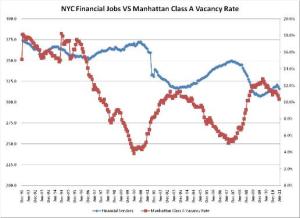The Financial Sector and the Manhattan Office Market
By Tom Acitelli August 12, 2011 11:44 am
reprints
How do they get along, exactly? Robert Sammons of Cassidy Turley breaks it down.
New York City and the financial services industry are thought to be B.F.F.’s (“best friends forever,” for those not in the know). The accompanying graph does, indeed, show the correlation between financial services jobs (banking, securities and insurance) and the Manhattan Class A vacancy rate. For the most part, the two statistics do follow the expected pattern: as financial jobs fall, the vacancy rate rises, and vice versa. But there are also some interesting variations worth pointing out.
First, despite financial jobs in the early 1990s being at their highest levels in the past 20 years (topping out at 381,300 in December 1991), the vacancy rate was also quite steep. That had more to do with almost 52 million square feet of new office product coming online between 1981 and 1991 than anything else. After sliding in the mid-1990s, financial jobs did tick up again later that decade and into 2000 (hitting 372,200 in October 2000), though not enough to account for such a steep decline in the vacancy rate. That had more to do with growth within the larger professional and business services category as well as the infamous new media sector, which was red-hot at that point (though about to fall off a cliff).
Since 2003, there has appeared to be a tighter connection between the two data sets, not surprisingly, since financial services was the star of the most recent boom and bust. But the New York of today is not as dependent on this sector as it once was—just compare the over 380,000 jobs in this field 20 years ago versus the 316,200 today. Thankfully, other industries have been filling in the gaps. One of them is—surprise!—new media. Hopefully, this time it sticks around.
tacitelli@observer.com



